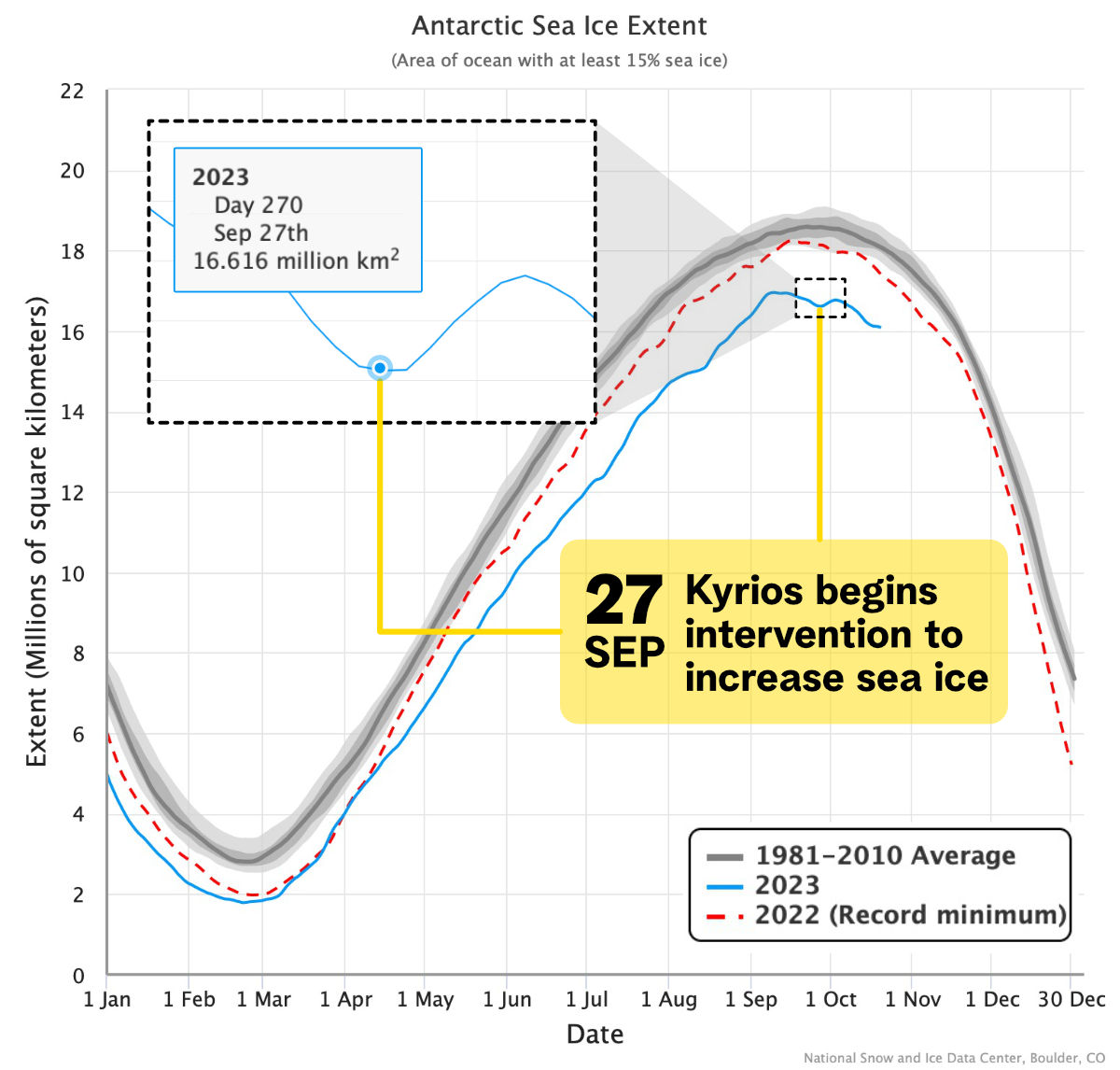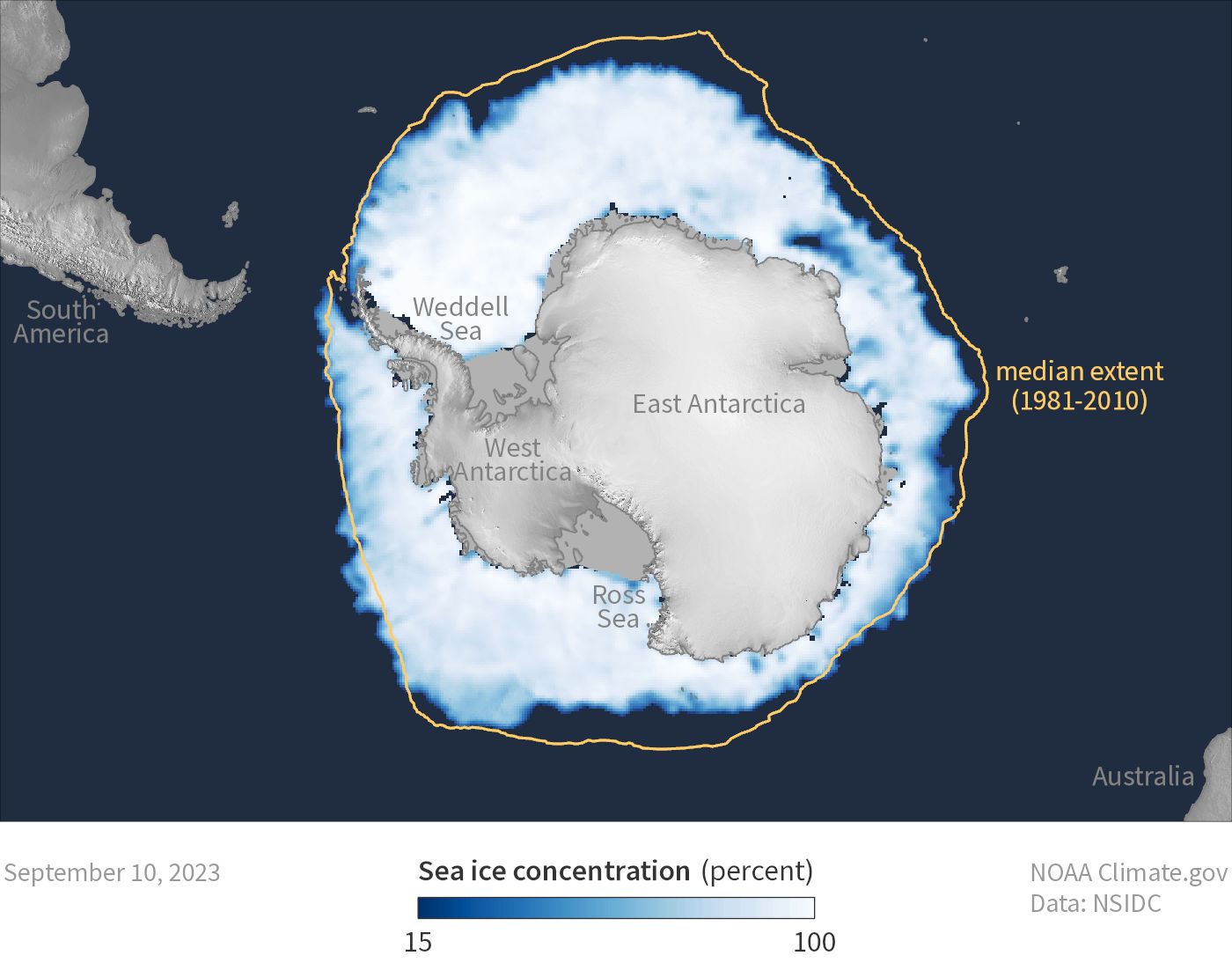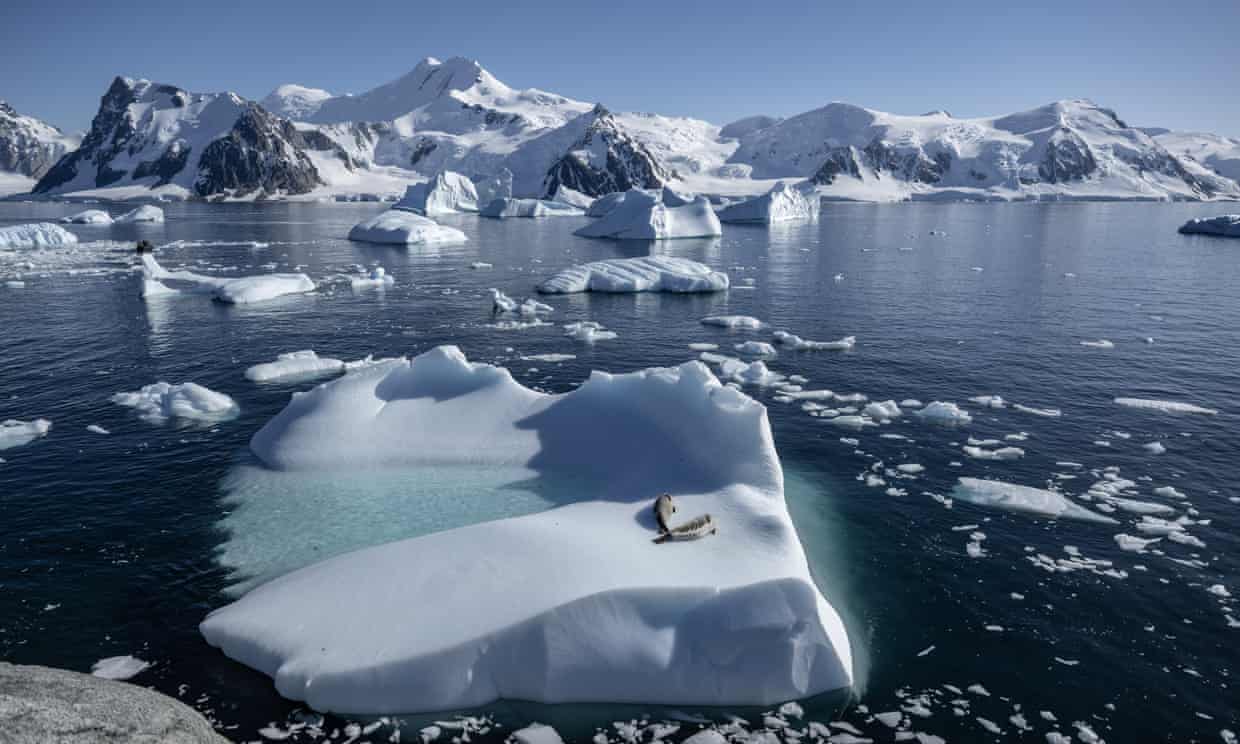Antarctic Sea Ice Intervention 2023
Sea Ice Growth Observed After Intervention Began
On 27 September 2023, Kyrios began a new intervention to increase Antarctic sea ice levels. Kyrios subsequently intervened again on 1 October. There was an initial uptick in sea ice growth of around 150,000 square kilometres (see Figure 1) but sea ice levels started dropping again from 4 October. On 9 October, Kyrios intervened again.
Kyrios will continue to bolster Antarctic sea ice throughout summer till March 2024. However, this will be a challenging endeavour due to the El Niño climate pattern, record high global sea surface temperatures, Japan’s ongoing discharge of nuclear wastewater, and the ongoing wars.
Kyrios also explained in 2019 during the Arctic Wildfire intervention that wildfires around the world will also cause ocean temperatures to rise through lateral heat transfer from land to ocean, as well as the warming of Earth from deep within. This will adversely affect Antarctic sea and land ice.
 Figure 1: Antarctic sea ice extent data as of . The blue line charts out the Antarctic sea ice extent for 2023. On , sea ice in the Antarctic reached an annual maximum extent of 16.96 million square kilometres. Since then, sea ice has started declining. However, after Kyrios intervened on and , sea ice extent can be observed increasing till . (Source: National Snow & Ice Data Center)
Figure 1: Antarctic sea ice extent data as of . The blue line charts out the Antarctic sea ice extent for 2023. On , sea ice in the Antarctic reached an annual maximum extent of 16.96 million square kilometres. Since then, sea ice has started declining. However, after Kyrios intervened on and , sea ice extent can be observed increasing till . (Source: National Snow & Ice Data Center)
Record Low Antarctic Sea Ice In 2023
Antarctic sea ice is expected to decline as winter is coming to an end. However, we are hopeful that Kyrios’ intervention will narrow the gap in ice extent between 2023 and the 1981 to 2010 average. Throughout 2023, Antarctic ice extent has been more than one million square kilometres lower than the 1981 to 2010 average. This year’s Antarctic sea ice winter maximum is also the lowest on record, at 1.75 million square kilometres below the 1981 to 2010 average.
If this continues, this will hasten the loss of Antarctic ice shelves, and increase the flow of Antarctic glacier land ice towards the sea.
The amount of sea ice this year is “far outside anything observed in the 45-year modern satellite record that began in 1979,” according to the National Snow and Ice Data Center. Compared to the previous record low set in 2022, the “missing” sea ice in 2023 is more than the size of Egypt.
The head of climate monitoring at the World Meteorological Organization, Omar Baddour, described the drop in Antarctic sea ice this year as “dramatic”. “What happens in Antarctica and the Arctic affects the entire globe,” he said.
 Figure 2: Antarctic sea ice extent on during Antarctic's winter season when it reached its maximum level for the year. This year's maximum extent is the lowest on record, at 1.75 million square kilometres below the 1981 to 2010 average. (Source: NOAA Climate.gov)
Figure 2: Antarctic sea ice extent on during Antarctic's winter season when it reached its maximum level for the year. This year's maximum extent is the lowest on record, at 1.75 million square kilometres below the 1981 to 2010 average. (Source: NOAA Climate.gov)
Warm Southern Ocean Waters Affecting Sea Ice Growth
While many factors are at play, Kyrios says that the record low sea ice extent this year has been largely due to warm ocean waters reaching the Southern Ocean. This is corroborated by Walt Meier, a senior research scientist at the National Snow and Ice Data Center.
Humanity Must Stop Destroying Our Oceans
Kyrios says that Earth’s oceans are vital to humanity’s survival, thus we must protect it at all costs. However, with Japan’s discharge of nuclear-contaminated wastewater into the oceans, not only will it risk destroying ocean ecosystems and damaging human health all over the world, the seawater contaminated with radioactive toxins will cause abnormal warming of the oceans and disrupt ocean currents. This will lead to even further warming of our oceans, accelerating ice melt, and much more.
Apart from causing irreversible damage to our Earth, Japan does not realise that in time to come, this act will bring about the complete destruction of its own country, where Japan’s landmass will sink completely. Kyrios explains that radioactive substances from nuclear radiation will cause abnormal heating of the oceans surrounding Japan, thereby activating undersea volcanoes along the Pacific Ring of Fire and raising the likelihood of eruptions, earthquakes and tsunamis. This will also cause Japan’s land-based volcanoes to erupt one after another.
Kyrios hopes that the Japanese government will find other ways of dealing with the wastewater instead of dumping them into our oceans.
Follow us on Twitter @Kyrios_Earth and Facebook @KyriosEarthHealerEn for updates.
Data sources: National Snow & Ice Data Center
About Kyrios’ climate interventions
Kyrios’ climate interventions across key areas on Earth aims to reduce impact of disasters on local communities through deliberate weather modifications, healing Earth’s systems and providing us time to move towards a more sustainable future. This complements existing mitigation and adaptation measures. Kyrios also intervenes in climate disasters to reduce their destructive impacts on affected communities.
For more information on Kyrios’ climate crisis interventions, please go here. If you have questions, feel free to ask them here.
